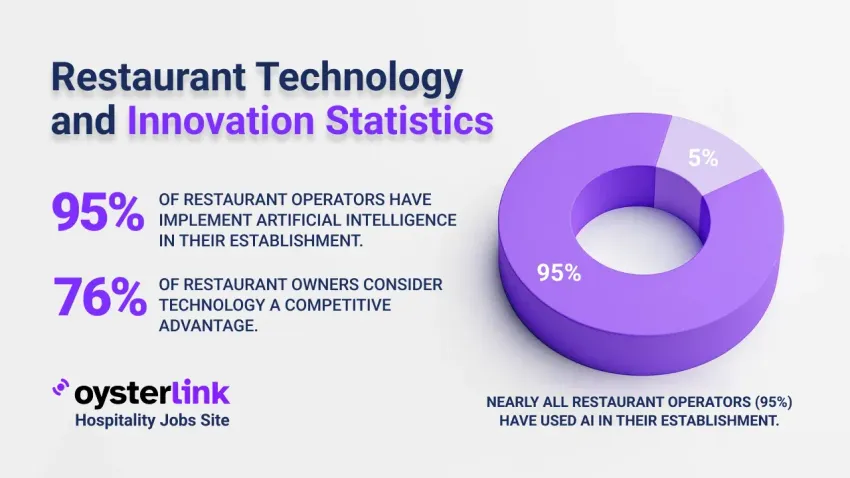Restaurant Technology and Innovation: Key Takeaways
- The global restaurant technology market was valued at $59.30 billion in 2024, with projections indicating a rise to $314.85 billion by 2033, representing a 16.39% compound annual growth rate.
- Over three-quarters (76%) of restaurant operators consider technology a competitive advantage, though many recognize the need for further integration.
- The vast majority (95%) of restaurant operators have implemented some form of artificial intelligence within their establishments.
The restaurant industry is experiencing a significant technological transformation, impacting operations and customer experiences.
This report highlights key restaurant technology and innovation statistics and trends observed in 2025, providing a data-driven overview of how restaurants are adopting and adapting to new technology.
The Explosive Growth of Restaurant Technology: A Market Overview
The global restaurant technology market demonstrates significant growth, reflecting the industry's increasing reliance on digital solutions.
In 2024, the market size was valued at $59.30 billion.
Projections indicate a substantial expansion, potentially reaching $314.85 billion by 2033, exhibiting a compound annual growth rate (CAGR) of 16.39% during the forecast period.

This growth trajectory signifies substantial investment in restaurant technology and reflects a broad recognition of its value in enhancing operational efficiency, improving customer experiences and driving revenue growth.
Factors contributing to this expansion include the:
- Increasing adoption of online ordering platforms
- Rise of mobile payment solutions
- Integration of AI-powered systems for tasks such as inventory management and personalized marketing.
Restaurant Technology as a Competitive Differentiator: Gaining an Edge in a Crowded Market
In an increasingly competitive restaurant industry, restaurant tech is emerging as a key differentiator.
A significant majority (76%) of restaurant operators report that technology provides a distinct competitive advantage.
This perception underscores the importance of technology in attracting and retaining customers, streamlining operations and optimizing resource allocation.
Restaurants leveraging technology can offer enhanced customer experiences through online ordering, mobile payments, personalized recommendations and loyalty programs.
Furthermore, technology enables operators to optimize internal processes, such as inventory management, staff scheduling and supply chain management, leading to reduced costs and improved efficiency.
Widespread AI Implementation: Transforming Restaurant Operations
The adoption of artificial intelligence (AI) is increasingly widespread within the restaurant industry, reflecting a growing recognition of its potential to transform various aspects of operations.
An impressive 95% of restaurant operators report using some form of AI, indicating its broad acceptance as a valuable tool for optimizing processes and improving decision-making.
AI-powered systems are being used in restaurants for a wide range of applications, including inventory management, demand forecasting, customer service and fraud detection.
Restaurant Automation: Streamlining Processes for Efficiency
Automation is becoming increasingly prevalent in various areas of restaurant management, reflecting a growing focus on improving efficiency, reducing costs and minimizing manual tasks.
Data indicates that 50% of restaurateurs have automated inventory management, 53% have automated email marketing and 47% have automated staff scheduling.
These automations streamline key processes, freeing up staff to focus on more strategic activities and enhancing overall operational efficiency.
Automation enhances efficiency by improving key operational areas, such as:
- Real-time inventory management and automated reordering to reduce stockouts and spoilage
- Personalized email campaigns to boost customer engagement and sales
- Automated staff scheduling to align staffing levels with demand, optimizing labor costs
The Barrier of Upfront Cost: Addressing the Financial Challenges of Technology Adoption
While the benefits of restaurant technology are widely recognized, high initial investment remains a significant obstacle to its broader adoption.
Approximately 28% of restaurateurs cite high upfront costs as the biggest barrier to implementing new technologies, highlighting the financial challenges associated with technology adoption.

The costs associated with purchasing and implementing new hardware, software and training can be substantial, particularly for small and independent restaurants.
The Rise of Cloud-Based POS Systems: Enhancing Accessibility and Scalability
The shift towards cloud-based point of sale (POS) systems is evident in the restaurant industry, reflecting a preference for the accessibility, scalability and cost-effectiveness offered by cloud solutions.
Approximately 63% of restaurants are currently utilizing cloud-based POS systems, while 34% continue to rely on legacy POS systems.
Cloud-based POS systems streamline operations with lower costs, simplified management and remote accessibility.
Furthermore, they enhance security, automate updates and integrate seamlessly with key restaurant technologies like online ordering and mobile payment.
Online Ordering Platform Adoption: A Near-Ubiquitous Practice
The use of online ordering platforms are now extremely prevalent in the restaurant industry, reflecting the changing preferences of today's consumers and the increasing importance of digital channels.
An overwhelming 99% of restaurants report using at least one online ordering platform, with most using an average of three platforms.
This widespread adoption underscores the critical role of online ordering in driving sales, expanding reach and enhancing customer convenience.
The Digital Foundation: Restaurant Websites as a Core Component of Online Presence
In the digital age, a basic website remains a critical component of a restaurant's online presence and a primary source of information for potential customers.
Approximately 69% of restaurant operators maintain a website for their establishment, indicating the recognition of its value in attracting customers, providing essential information and building brand awareness.
The Overall Customer View: Balancing Restaurant Technology With the Personal Touch for Enhanced Experiences
A majority of diners (59%) express comfort with technology in restaurants, indicating a general openness to tech-enhanced dining experiences.
However, it is important to recognize that this also means over 40% are either neutral or resistant to the technology.
This acceptance underscores the importance of balancing technological advancements with the core elements of hospitality, such as personalized service, attentive staff and a welcoming atmosphere.
Technology should be used to enhance the dining experience, not replace the human touch.
Restaurants should strive to create a seamless and integrated experience where technology complements and supports the interactions between staff and customers.
Methodology
This report synthesizes data from primary industry sources to analyze restaurant technology trends.
Key findings are drawn from reports published by Market Intelligence, National Restaurant Association and TouchBistro.









Loading comments...